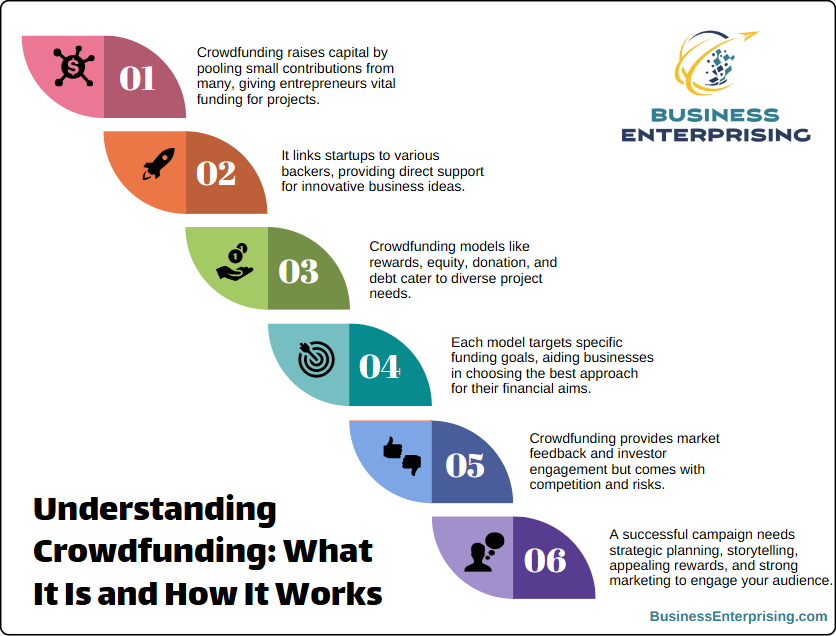
Understanding Crowdfunding: What It Is and How It Works
Crowdfunding is a method of raising small amounts of money from a large number of individuals to finance a new business venture. This approach leverages the internet and social media to connect entrepreneurs with potential backers. By presenting your business idea on crowdfunding platforms, you can reach a broad audience willing to invest modest sums.
As an entrepreneur, you can use crowdfunding to gather the necessary capital for your business. This strategy allows you to bypass traditional funding avenues, such as banks or venture capitalists. Instead, you appeal directly to individuals who believe in your idea. This democratizes the fundraising process, making it more accessible to a wider range of businesses.
To launch a crowdfunding campaign, you typically create a detailed proposal on a crowdfunding platform. This proposal should clearly explain your business concept, funding goals, and how you plan to use the raised funds. Potential backers review your proposal and decide whether to contribute. In return, they might receive rewards, equity, or simply the satisfaction of supporting a new venture, depending on the crowdfunding model you choose.
Crowdfunding as a business funding strategy not only provides capital but also helps validate your business idea. A successful campaign indicates market interest and can build a community around your brand. However, it’s important to note that running a successful crowdfunding campaign requires careful planning, clear communication, and ongoing engagement with your backers.
Types of Crowdfunding: Choosing the Right Model for Your Business
When considering crowdfunding as a business funding strategy, it’s important to understand the various models available. Each model offers distinct advantages tailored to different business needs.
Rewards-based crowdfunding involves backers contributing funds in exchange for a product or service. This model suits businesses launching new products, as it allows you to validate demand and generate interest before production.
Equity-based crowdfunding enables you to offer shares of your company to investors. This approach is ideal if you’re seeking substantial capital and are willing to share ownership. However, it requires compliance with securities regulations, which can be complex.
Donation-based crowdfunding relies on contributions without expecting financial returns. This model works well for charitable projects or community initiatives. However, it’s less suitable for profit-driven businesses, as donors typically support causes rather than commercial ventures.
Debt-based crowdfunding, also known as peer-to-peer lending, involves borrowing funds from multiple investors with a promise to repay with interest. This model benefits businesses that prefer debt over equity dilution. However, you’ll need a solid repayment plan to attract lenders.
By understanding these models, you can choose the one that aligns best with your business objectives and funding requirements.
Pros and Cons of Crowdfunding for Business Funding
Crowdfunding as a business funding strategy offers several advantages. It allows you to validate your product or service by gauging public interest before full-scale production. Additionally, a successful campaign can generate buzz, attracting media attention and expanding your customer base. Moreover, crowdfunding provides an opportunity to engage directly with backers, fostering a sense of community and loyalty around your brand.
However, there are potential downsides to consider. The crowdfunding space is competitive, making it challenging to capture potential backers’ attention. Furthermore, running a campaign demands significant time and effort in planning, marketing, and communication. There’s also the risk of not reaching your funding goal, which could result in receiving no funds, depending on the platform’s policies. Additionally, publicly sharing your business idea exposes it to potential imitation by competitors.
In summary, while crowdfunding offers a unique avenue for raising capital and engaging with your audience, it’s essential to weigh these benefits against the associated risks. Careful planning and execution are crucial to maximize the advantages and mitigate potential drawbacks.
How to Create a Successful Crowdfunding Campaign
Creating a successful crowdfunding campaign involves careful planning and execution. Begin by setting a clear, realistic funding goal that aligns with your project’s needs. This clarity helps potential backers understand your objectives. Additionally, crafting a compelling narrative is essential. Share the story behind your project, highlighting its purpose and the problem it addresses. This personal touch can resonate with backers, fostering a deeper connection to your mission.
Offering attractive perks can further entice supporters. Consider providing exclusive items or early access to your product as tokens of appreciation. These incentives can motivate contributions and generate excitement around your campaign. Moreover, a well-thought-out marketing strategy is vital. Utilize social media platforms, email newsletters, and press releases to spread the word. Engaging with your audience through these channels can amplify your reach and attract more backers.
Remember, the success of crowdfunding as a business funding strategy hinges on your ability to connect with potential backers. By setting clear goals, telling a compelling story, offering appealing perks, and implementing a robust marketing plan, you can create a campaign that resonates and achieves its funding objectives.
Popular Crowdfunding Platforms and How to Choose One
When considering crowdfunding as a business funding strategy, selecting the right platform is crucial. Kickstarter, Indiegogo, and GoFundMe are among the most popular options, each catering to different types of projects. Kickstarter focuses on creative endeavors and operates on an all-or-nothing funding model, meaning you only receive funds if you meet your goal. Indiegogo offers more flexibility, allowing both fixed and flexible funding options, which can be beneficial if you’re uncertain about reaching your target. GoFundMe is tailored for personal causes and emergencies, making it less suitable for business ventures.
Equity-focused platforms like Fundable and StartEngine enable you to offer investors a stake in your company. These platforms are ideal if you’re willing to share ownership to secure larger investments. However, they often require more rigorous financial disclosures and adherence to securities regulations.
When choosing a platform, consider factors such as fees, audience, and success rates. Most platforms charge a fee of around 5% of the total funds raised, plus payment processing fees. Kickstarter and Indiegogo have large, active communities interested in innovative products, which can increase your campaign’s visibility. However, the competitive nature of these platforms means that only a fraction of campaigns reach their funding goals. Therefore, aligning your project’s nature with the platform’s audience and understanding the associated costs are essential steps in selecting the most suitable crowdfunding platform for your business.
Case Studies: Successful Crowdfunding Campaigns and Lessons Learned
Examining successful crowdfunding campaigns offers valuable insights into effective strategies. For instance, the Pebble Time smartwatch campaign on Kickstarter raised over $20 million, becoming one of the platform’s most funded projects. The creators emphasized clear communication and regular updates, fostering trust and maintaining backer interest.
Similarly, the Exploding Kittens card game campaign achieved remarkable success by leveraging humor and a strong community presence. The team behind the project engaged potential backers through entertaining content and interactive updates, creating a sense of involvement and excitement.
These examples highlight key practices for crowdfunding as a business funding strategy. Crafting a compelling narrative, maintaining open communication, and actively engaging with your audience can significantly enhance your campaign’s success. Additionally, offering appealing rewards and fostering a sense of community around your project can further motivate backers to support your venture.
Conclusion
Crowdfunding offers a dynamic avenue for securing business funding. By engaging directly with potential backers, you can validate your ideas and build a loyal customer base. However, it’s essential to recognize the challenges involved. The competitive nature of crowdfunding demands meticulous planning and a compelling presentation. Additionally, selecting the appropriate platform requires careful consideration of your project’s goals and target audience. By weighing these factors thoughtfully, you can determine if crowdfunding aligns with your business objectives. Ultimately, with strategic execution, crowdfunding can serve as an effective tool to bring your business vision to fruition.



